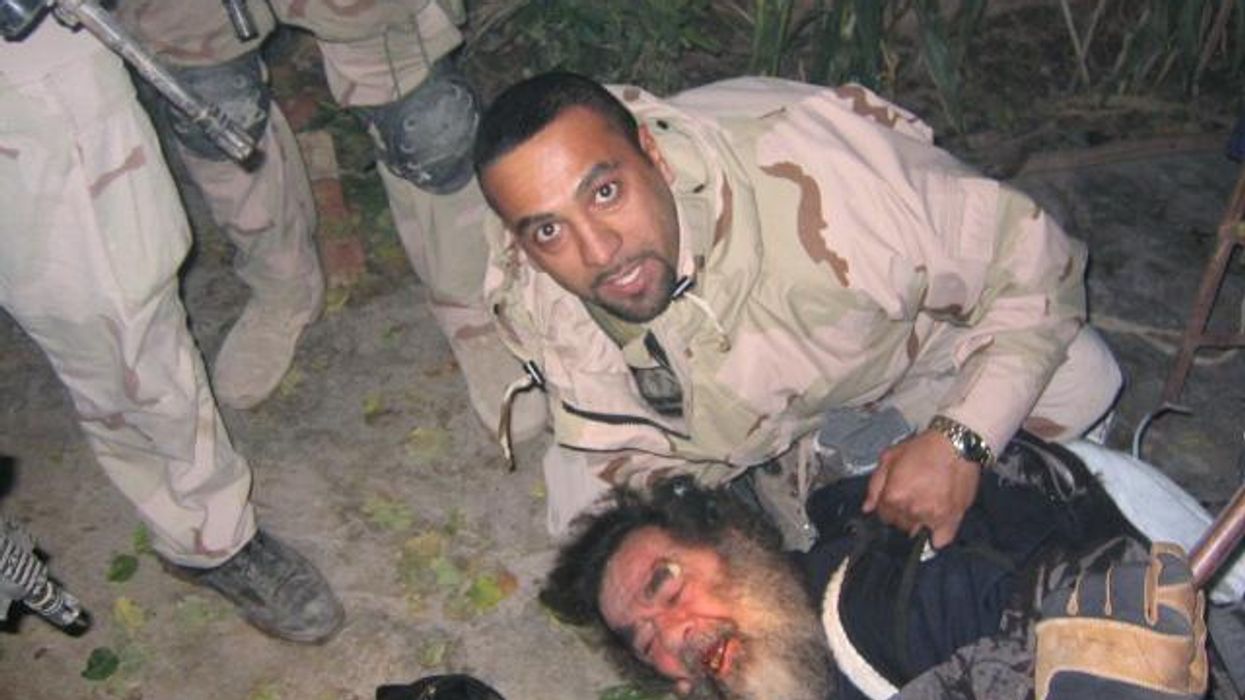The Bunker appears originally at the Project on Government Oversight and is republished here with permission.
Congress is MIA when it comes to war
In serious matters of war and peace, Congress has decided, yet again, to take a pass. By a vote of 51-48, the Senate on October 8 voted down a bipartisan proposal that would have required congressional approval before the Trump administration carries out additional strikes against suspected drug-smuggling boats in the Caribbean Sea bound for the U.S. It represents yet another lawmaker leap into irrelevance regarding one of the fundamental duties of the legislative branch of the U.S. government.
It also telegraphs something new: In the past, Congress has often passed an Authorization for the Use of Military Force (technical legal name: fig leaf, from the Latin meaning “don’t blame us”) before a president ordered military attacks. But this time around, lawmakers are so weak-kneed they’re refusing even to backdate a blank check for combat.
In recent weeks, the administration has acknowledged five such attacks. They have killed, by the administration’s own count, 27 people it labeled as Venezuelan “narco-terrorists.” The White House maintains the U.S. is engaged in an “armed conflict” with “unlawful combatants.” So it has chosen to respond by launching its own armed conflict through unlawful attacks.
Trump administration justifications for the attacks have been both meager and dubious. “Can you imagine a doctrine in which we just blow up ships off of Miami and say ‘whoops’ if they didn’t have any drugs on board?” Senator Rand Paul (R-KY) said (PDF) on the Senate floor. “We allow searches. But we don’t kill every suspected boat off of Miami suspected of having drugs because 25 percent of them don’t have any drugs.”
It is illegal for the U.S. military to target civilians who — even if they may be peddling narcotics — are not engaged in “hostilities” against the United States, the Army’s former top law-of-war officer told the New York Times. “This is not stretching the envelope,” Geoffrey Corn added. “This is shredding it. This is tearing it apart.”
The Bunker is not in favor of drug smugglers. It just would like to see those in charge stay within the well-established boundaries of the laws of war. And that has to start with Congress, charged in Article 1, Section 8 of the U.S. Constitution to debate, and then to declare or not declare, war on enemies of the United States. At a minimum, U.S. citizens deserve to see the Congress they pay take a stand. But lily-livered lawmakers haven’t seen fit to step up to the plate and declare war against any state or organization since 1942. Their abdication comes despite dozens of combat deployments since then, some of which — Korea, Vietnam, Iraq, Afghanistan, Iraq 2.0 — surely warranted such a debate.
Each week seems to bring an ever-tighter ratcheting of autocracy to the U.S. government. First it was over ballots. Now it is over bullets.
Aimed at them.
For now.
The F-35 still spends too much time on the tarmac
When The Bunker was but a boy, he grew up in a Chevrolet neighborhood. Dad would get upset whenever someone parked a new Cadillac in their driveway. “More money than brains,” he’d grouse. “Living beyond their means.” Dad may have died 35 years ago, but if he were still with us, he’d be saying the same thing about the Pentagon’s $2 trillion F-35 program.
“The F-35 remains the most advanced fighter in the world, but too many of them are sitting idle on ramps,” Senator Roger Wicker (R-MS), chairman of the Senate Armed Services Committee, groused at the soon-to-be top Air Force general at his October 9 confirmation hearing. “The Air Force cannot project power if its most advanced fighter cannot get off the ground.”
This is a perennial problem for a military more concerned with presents (gold-plated weapons favored by generals and defense contractors) than presence — the ability to get to the fight and prevail. It too often leads to a bevy of hangar queens. “Our pilots are flying about two to two-and-a-half times a week in a fighter aircraft,” General Kenneth Wilsbach, tapped to be the service’s next chief of staff, conceded to the Senate panel. “That is not enough.”
Building an air force (the Marines and Navy also fly F-35s) is a tough balancing act that would challenge the Flying Wallendas:
- Long-standing Pentagon logic says more costly warplanes are better warplanes.
- But more expensive warplanes require more money to buy, and, more critically, to keep them flying. The Air Force’s F-35 broke down nearly twice as often as planned in 2023. Its readiness rate fell from a poor 69% of the time in 2021 to a pitiful 52% in 2024.
- Inevitably, the more money the U.S. military spends on keeping its aircraft flying, the fewer hours those planes can fly. “That means that you can’t fly your full fleet,” Wilsbach said. “What that means is the pilots and the crews aren’t training.”
- Highly-trained pilots — it costs more than $13 million (PDF), in 2025 dollars, to train an F-35 pilot — love to fly. They don’t take well to hours sitting in simulators or hanging around ready rooms waiting for their planes to be repaired. Flight hours for Air Force combat pilots have dived from 16 per month in the 1990s, to 10 in the mid-2010s, to about five hours monthly today.
- So they’re more inclined to bail out of the service, forcing the military to spend $13 million training replacements.
- That, in turn, takes $13 million per new pilot that can’t be spent on maintenance, leading to fewer flying hours, air infinitum.
Wilsbach, predictably, said the Pentagon should spend more money to keep F-35s airborne. But a former top Air Force officer says service leaders “can use our imaginations” to solve the flying-hour crunch. Merrill McPeak, a fighter pilot who served as Air Force chief of staff from 1990 to 1994, suggests his service equip its F-35 units with gliders to keep their pilots flying. “Time spent in the air flying anything builds airmanship and confidence,” he says. “Better still, it’s fun.”
Then again, thinking of good ol’ Dad, we could just fly Buicks.
Pentagon press to be branded with scarlet letters
Pete Hegseth’s Department of Defense has launched a war against the press. Like the war in Afghanistan, it is not going to end well for the Pentagon. Sure, the flag-pocket-squared SECDEF can bombard those in uniform with a barrage of memos and require them to salute. But the Pentagon press corps — like all reporters, bolstered by the nation’s founders — prizes its independence.
The Bunker spent 37 years reporting from inside the Pentagon, seeking to inform readers about what the U.S. military was doing in their name. He was proud to tell their stories, but didn’t pull punches, either. He was more concerned with being fair than being friendly. He believes he earned a career’s worth of respect from most of those in uniform.
This October 6 memo (PDF) from Sean Parnell, Hegseth’s spokesman, reads like an OPLAN for an attack on the First Amendment and those who embrace it. It reads as if this Pentagon hierarchy views the press as the enemy. Hegseth & Co. seem oblivious to the need for independent and robust reporting on the U.S. military. They are trying to squelch the press from doing its job with a crude one-two punch: First, dramatically cut down on officially released information, and second, bar reporters from “soliciting” (also known as “reporting”) anything else.
News organizations are making it clear they will not agree to its terms. That could lead to their “chaotic withdrawal” from the building beginning October 15, much like the U.S. left Afghanistan in 2021, one veteran Pentagon scribe told The Bunker. “This whole episode stems from Hegseth’s hatred of the media because of the coverage he received leading up to his nomination and after,” he believes.
And here’s the bright red maraschino cherry on top: The Defense Department also will soon begin issuing “Additional Press Identifier Badges” (PDF) that, according to Parnell’s memo, “will have ‘PRESS’ clearly imprinted on them in red letters both vertically and horizontally to assist in identifying members of the press within the Pentagon.”
Here’s hoping they print up one labeled “FOOL” for themselves, as well.
Here’s what has caught The Bunker’s eye recently
Hundreds of small defense companies are sprouting in Rust Belt cities thanks to local talent, cheap labor and state cash incentives, Sheera Frenkel reported October 13 in the New York Times.
→ “Luke Skywalker, call your office!”
President Trump’s Golden Dome missile shield would rely heavily on space-based missile interceptors, an unparalleled technical challenge, Josh Luckenbaugh reported October 7 in National Defense.
→ Ripe for dishonorable plunder
The VA’s rapidly expanding disability benefits program has become a rich target for fraudsters, the Washington Post’s Craig Whitlock, Lisa Rein, and Nate Jones reported October 8.
Thanks for stopping by The Bunker this week. Consider forwarding on to allies so they can subscribe here.
- Trump hails US airstrike against smugglers in the Caribbean ›
- Trump doubles down on strikes against alleged smugglers in Caribbean ›
- Why is Congress MIA on looming Venezuela war? ›
- GOP senator: Congress in dark on ‘narco’ strikes | Responsible Statecraft ›
- The top US military contractors cashing in on Caribbean operations | Responsible Statecraft ›
















